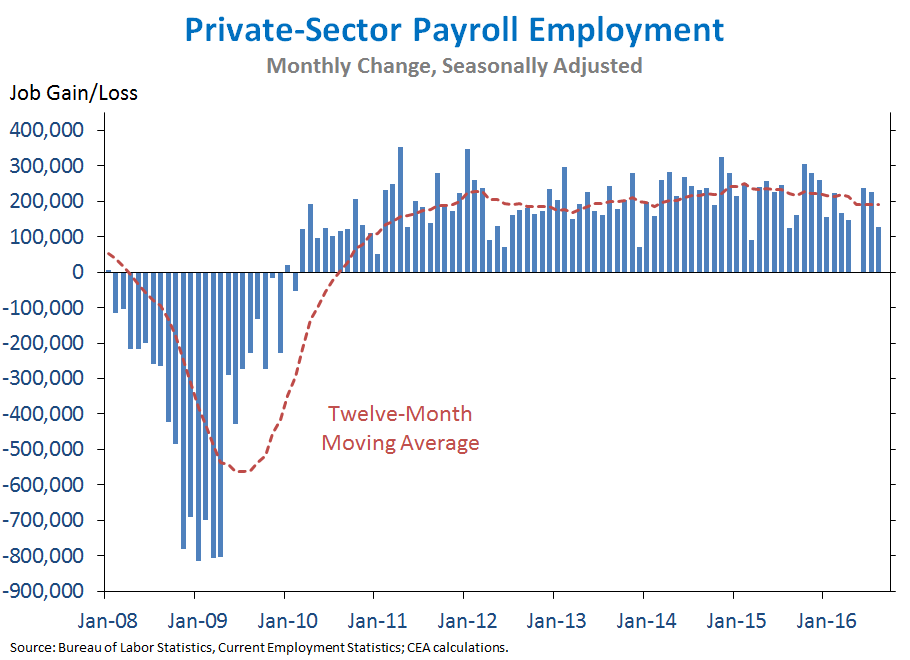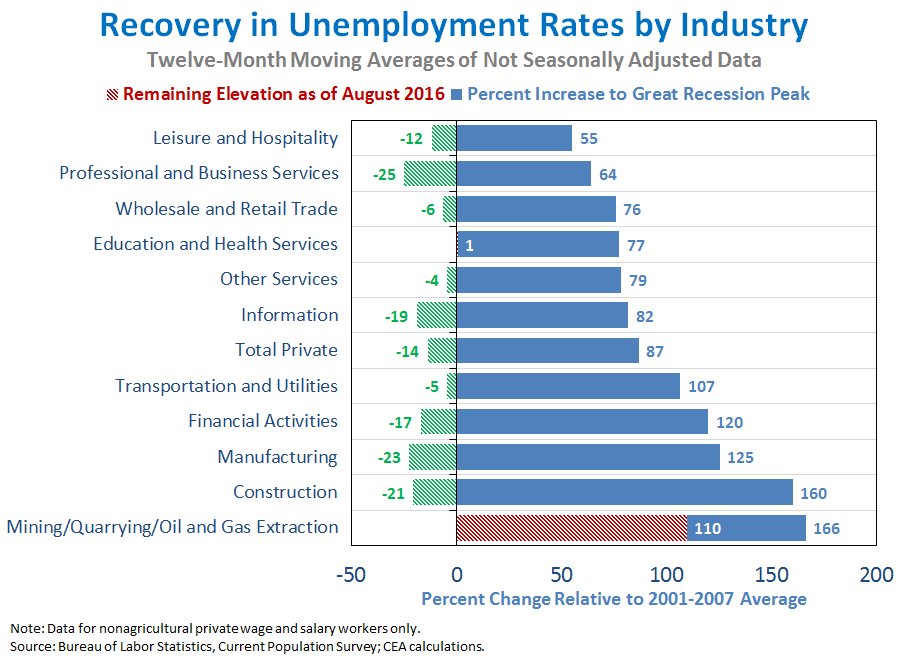The White House issued this Fact Sheet about the third revision in second quarter economic growth estimates:
WASHINGTON, DC – Jason Furman, Chairman of the Council of Economic Advisers, issued the following statement today on the third estimate of GDP for the second quarter of 2016. You can view the statement HERE.
Summary: Real GDP growth in the second quarter was revised up to 1.4 percent at an annual rate according to BEA’s third estimate.
Second-quarter economic growth was revised to 1.4 percent at an annual rate in the third estimate, up 0.3 percentage point from the second estimate. Consumer spending grew strongly at 4.3 percent in the second quarter—its second-fastest quarterly growth since 2006—and, in contrast to recent quarters, net exports and business fixed investment also added to GDP growth. Some of this growth was offset by a large decline in inventory investment (one of the most volatile components of GDP), along with declines in residential investment and government spending. Overall, growth in the most stable and persistent components of output—consumption and fixed investment—was revised up to 3.2 percent. Today’s report underscores that there is more work to do, and the President will continue to take steps to strengthen economic growth and boost living standards by promoting greater competition across the economy; supporting innovation; and calling on Congress to increase investments in infrastructure and to pass the high-standards Trans-Pacific Partnership.
FIVE KEY POINTS IN TODAY’S REPORT FROM THE BUREAU OF ECONOMIC ANALYSIS (BEA)
- Real Gross Domestic Product (GDP) increased 1.4 percent at an annual rate in the second quarter of 2016, according to BEA’s third estimate. Consumer spending grew 4.3 percent, well above its pace over the prior four quarters, with faster growth in both durable and nondurable goods spending. In addition, export growth was positive in the second quarter, and net exports contributed positively to GDP growth. Nonresidential fixed investment increased modestly in the second quarter, with strong growth in intellectual property products investment (see point 4 below) offset by continued weakness in both structures and equipment investment. Inventory investment—one of the most volatile components of GDP—subtracted 1.2 percentage points from GDP growth. Residential investment contracted following eight straight quarters of increases.
Real Gross Domestic Income (GDI)—an alternative measure of output—decreased 0.2 percent at an annual rate in the second quarter. (In theory, GDP and GDI should be equal, but in practice they usually differ because they use different data sources and methods.) The average of real GDP and real GDI, which CEA refers to as real Gross Domestic Output (GDO), increased 0.6 percent at an annual rate in the second quarter. CEA research suggests that GDO is a better measure of economic activity than GDP (though not typically stronger or weaker).

- Second-quarter real GDP growth was revised up 0.3 percentage point, though the overall pattern of growth remained largely unchanged following revisions. Revisions in the third estimate included an upward revision to nonresidential fixed investment (which now is estimated to have made a positive contribution to GDP growth), reflecting a smaller contraction in structures investment than originally estimated. Smaller upward revisions to exports and inventory investment were partly offset by a small downward revision to the services component of consumer spending.
In today’s release, BEA revised down its estimate of real GDI growth in the second quarter from an increase of 0.2 percent to a decrease of 0.2 percent due to a downward revision to State-level data on indirect business taxes.

- Real personal consumption expenditures, which account for over two-thirds of GDP, grew 4.3 percent at an annual rate in the second quarter, supported by rising real incomes. The second quarter of 2016 ranked as the second-strongest quarter for consumer spending growth since 2006. Consumer spending contributed 2.9 percentage points to GDP growth in the second quarter, reflecting improved economic conditions for many households. This month, the Census Bureau reported that real median household income increased 5.2 percent from 2014 to 2015, the fastest annual growth on record. Data from 2016—including a continued solid pace of job growth and a noticeable pickup in real hourly earnings—point to further strong gains in household incomes. The chart below shows four-quarter percent changes in real consumer spending and in aggregate real wages and salaries paid by domestic employers. The two series tend to move closely together, though the correlation between the two fell during the 2000s business cycle, as growth in consumer spending far outpaced growth in real aggregate wages and salaries. This was likely due to the rapid accumulation of household debt during this period, which sustained the faster growth in consumption. Deleveraging by households over the recession and the recovery has sharply increased the correlation of growth in wages and consumer spending in the current business cycle, such that recent gains in real incomes are likely to support continued strength in consumer spending growth in future quarters.

- Real private investment in research and development (R&D) made a larger contribution to GDP growth in the second quarter than in any previous quarter on record. Private R&D investment contributed 0.28 percentage point to overall GDP growth, accounting for most of the 9.0-percent growth in intellectual property products (IPP) investment and offsetting weakness in other components of business fixed investment. Private R&D investment grew at a 17.0-percent annual rate in the second quarter, the second-fastest quarterly growth since 1960. Private R&D investment has reached an all-time high as a share of overall output. Although this share (1.8 percent) is still relatively small, increased investment in R&D can help boost productivity growth in the future, which will be needed to help reverse the slowdown across advanced economies in the last decade.

- Real private domestic final purchases (PDFP)—the sum of consumption and fixed investment—rose 3.2 percent at an annual rate in the second quarter, noticeably faster than overall GDP growth. PDFP—which excludes more volatile components of GDP like net exports and inventory investment, as well as government spending—is generally a more reliable indicator of next-quarter GDP growth than current GDP. In the second quarter, the divergence between the strong contribution of PDFP to growth and the relatively slower growth of overall real GDP was largely accounted for by the large negative contribution of inventory investment. Overall, PDFP rose 2.3 percent over the past four quarters, above the pace of GDP growth over the same period.

As the Administration stresses every quarter, GDP figures can be volatile and are subject to substantial revision. Therefore, it is important not to read too much into any single report, and it is informative to consider each report in the context of other data as they become available.








